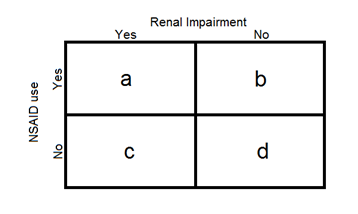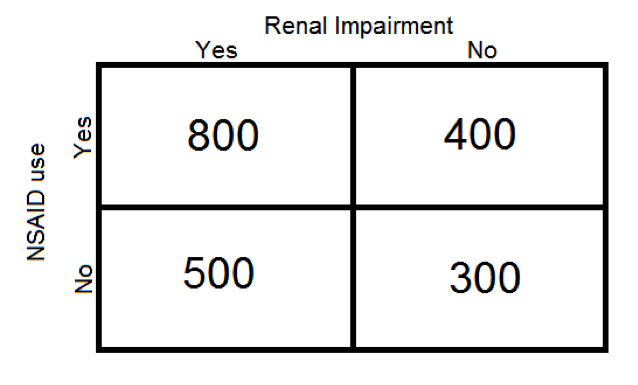WBR0391: Difference between revisions
Jump to navigation
Jump to search
No edit summary |
No edit summary |
||
| Line 1: | Line 1: | ||
{{WBRQuestion | {{WBRQuestion | ||
|QuestionAuthor={{Rim}} | |QuestionAuthor={{Rim}}, {{AJL}} {{Alison}} | ||
|ExamType=USMLE Step 1 | |ExamType=USMLE Step 1 | ||
|MainCategory=Biostatistics/ Epidemiology | |MainCategory=Biostatistics/ Epidemiology | ||
| Line 20: | Line 20: | ||
|MainCategory=Biostatistics/ Epidemiology | |MainCategory=Biostatistics/ Epidemiology | ||
|SubCategory=Renal | |SubCategory=Renal | ||
|Prompt=A case-control study investigating the association between the current use of non-steroidal anti-inflammatory drugs (NSAIDs), for more than 1 year, and impaired renal function. | |Prompt=A case-control study investigating the association between the current use of non-steroidal anti-inflammatory drugs (NSAIDs), for more than 1 year, and impaired renal function. 2000 males and females over the age of 50 are surveyed and the results of the study have been categorized in the following table. Which of the following numbers represents the odds ratio for renal impairment among patients with a history of NSAID use, versus those without a history of NSAID use? | ||
[[Image:NSAID use WBR.png|300px]] | [[Image:NSAID use WBR.png|300px]] | ||
|Explanation=[[Image:NSAID use WBR odds ratio.png|300px]] | |Explanation=[[Image:NSAID use WBR odds ratio.png|300px]] | ||
The odds ratio (OR) in this scenario is calculated using the equation: | |||
OR = ad/bc = (800 x 300)/(400 x 500) = 240000/200000 = 1.2 | OR = ad/bc = (800 x 300)/(400 x 500) = 240000/200000 = 1.2 | ||
|EducationalObjectives= The odds ratio is calculated using the equation: OR = ad/bc | |||
|References= First Aid 2014 page 50 | |||
|AnswerA=0.041 | |AnswerA=0.041 | ||
|AnswerAExp=0.041 | |AnswerAExp=0.041 represents the attributable risk, calculated using the following equation: | ||
Attributable Risk = (a/[a+b]) – (c/[c+d]) | Attributable Risk = (a/[a+b]) – (c/[c+d]) | ||
|AnswerB=0.500 | |AnswerB=0.500 | ||
|AnswerBExp=0.500 does not correspond to any value. | |AnswerBExp=0.500 does not correspond to any relevant value. | ||
|AnswerC=1.066 | |AnswerC=1.066 | ||
|AnswerCExp=1.066 | |AnswerCExp=1.066 represents the relative risk (RR), often used in cohort studies, calculated with the following equation: | ||
RR = (a/[a+b]) / (c/[c+d]) | RR = (a/[a+b]) / (c/[c+d]) | ||
|AnswerD=1.200 | |AnswerD=1.200 | ||
|AnswerDExp=1.200 correctly corresponds to the odds ratio. | |AnswerDExp=1.200 correctly corresponds to the odds ratio. | ||
|AnswerE=1.500 | |AnswerE=1.500 | ||
|AnswerEExp=1.500 does not correspond to any value. | |AnswerEExp=1.500 does not correspond to any relevant value. | ||
|RightAnswer=D | |RightAnswer=D | ||
|Approved= | |WBRKeyword= odds ratio, OR, formulas, formula, case-control, equation | ||
|Approved=Yes | |||
}} | }} | ||
Revision as of 15:35, 17 July 2014
| Author | [[PageAuthor::Rim Halaby, M.D. [1], Alison Leibowitz [2] (Reviewed by Alison Leibowitz)]] |
|---|---|
| Exam Type | ExamType::USMLE Step 1 |
| Main Category | MainCategory::Biostatistics/ Epidemiology |
| Sub Category | SubCategory::Renal |
| Prompt | [[Prompt::A case-control study investigating the association between the current use of non-steroidal anti-inflammatory drugs (NSAIDs), for more than 1 year, and impaired renal function. 2000 males and females over the age of 50 are surveyed and the results of the study have been categorized in the following table. Which of the following numbers represents the odds ratio for renal impairment among patients with a history of NSAID use, versus those without a history of NSAID use? |
| Answer A | AnswerA::0.041 |
| Answer A Explanation | [[AnswerAExp::0.041 represents the attributable risk, calculated using the following equation:
Attributable Risk = (a/[a+b]) – (c/[c+d])]] |
| Answer B | AnswerB::0.500 |
| Answer B Explanation | AnswerBExp::0.500 does not correspond to any relevant value. |
| Answer C | AnswerC::1.066 |
| Answer C Explanation | [[AnswerCExp::1.066 represents the relative risk (RR), often used in cohort studies, calculated with the following equation:
RR = (a/[a+b]) / (c/[c+d])]] |
| Answer D | AnswerD::1.200 |
| Answer D Explanation | AnswerDExp::1.200 correctly corresponds to the odds ratio. |
| Answer E | AnswerE::1.500 |
| Answer E Explanation | AnswerEExp::1.500 does not correspond to any relevant value. |
| Right Answer | RightAnswer::D |
| Explanation | [[Explanation::
The odds ratio (OR) in this scenario is calculated using the equation:
OR = ad/bc = (800 x 300)/(400 x 500) = 240000/200000 = 1.2 |
| Approved | Approved::Yes |
| Keyword | WBRKeyword::odds ratio, WBRKeyword::OR, WBRKeyword::formulas, WBRKeyword::formula, WBRKeyword::case-control, WBRKeyword::equation |
| Linked Question | Linked:: |
| Order in Linked Questions | LinkedOrder:: |
